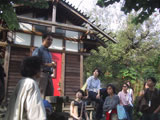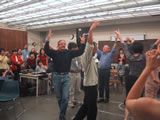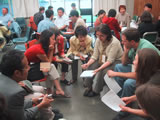Working Conferences and Papers / 2004 Seattle, USA




(Re)constructing Communities/ design participation in the face of change
September
2-5, 2004
Statement
Community
design is the practice of enhancing local social and environmental
well-being with the active and informed participation of communities.
In countries and regions across the Pacific Rim, community development
and community planning has become an increasingly important component
of the urban planning and design process. From advocacy planning
and citizen participation developed in the United States, models of
citizen participation and community planning now can also be found in
Japan, Taiwan, Hong Kong and even Mainland China. The movement
toward public involvement in decision-making process that emerged in
the civil rights movement in the United States has been echoed by the
Machizukuri (neighborhood building) Movement in Japan, the Community
Building Movement (Sher-chu-zong-ti-yin-zhao) in Taiwan, and an emerging
challenge to the top-down urban planning and redevelopment process in
Hong Kong. More
recently, decentralization
of decision-making in Mainland China has led to more government-led
community building programs, and some experiments in participatory
planning processes.
The
parallel movements across the Pacific Rim reflect a strong influence
of the ideology of democratic decision-making and community building
shared by many practitioners in
architecture, landscape architecture, planning, and urban design.
However, while the idealism of community building begins to take hold,
recent social changes across the Pacific Rim have in turn challenged
the traditional notion of unitary community and the established local
political process. In the U.S., continued immigration and
demographic shift have challenged the composition, identity and values of
communities in cities and regions. In Japan and Taiwan, continued
urbanization is also changing the demographic makeup of traditional
communities that led to competing interests and ideologies among different
sectors of the societies. New urban patterns and population flow are
changing people’s place identities and pitted newcomers against
long-time residents. In Hong Kong, the traditional consultation
process is no longer adequate in addressing conflicts and contentions in
the redevelopment of aging urban communities. In China, the drive
toward economic development has outpaced institutional and social adjustments.
In recent years, there have been significant advances in research and practice related to community design in the Pacific Rim countries. At the same time, the growing practice of community planning and the conditions of changing communities present interesting parallels and differences across the Pacific Rim and provide opportunities of critical comparisons and analysis. First, as community planning has become institutionalized in the U.S. and Canada, its practice has increasingly become parochial and focusing primarily on procedures. In contrast, community design in the form of social movements in Taiwan and Japan could provide lessons and help reinvigorate the institutionalized practice of community design in the U.S.. Conversely, the U.S. experience could offer forewarnings to future problems in its Asian counterparts. Second, in North America, the growth of new immigrant and multicultural communities in cities has put new strains on many traditional institutions of democratic participation, and requires a re-envisioning of the democratic process in response to the multicultural and cross-cultural context. Similarly, debates concerning multiculturalism have also begun to emerge in Asian countries as result of growing acknowledgement of cultural differences and politics of pluralism and democracy. The experience in the U.S. could offer important lessons for the Asian countries and communities. Third, the changes in the Pacific Rim are increasingly transnational and interrelated. A cross-cultural and transnational examination of the experience across the Pacific Rim will contribute to a better understanding of the ongoing transformation in cities and communities that are results of increasing economic and social ties between the U.S. and other Pacific Rim countries.
Conference Statement
PROCEEDINGS & FULL PAPERS (NEW!)
Conference Sponsored by:
Department of Landscape Architecture, College of Architecture and Urban Planning (University of Washington)
Landscape Architecture Program (University of California, Davis)Northwest Center for Livable Communities (University of Washington)
With support from Pacific Rim Research Program, University of California, Taiwan Ministry of Education, and Department of Landscape Architecture, University of Washington